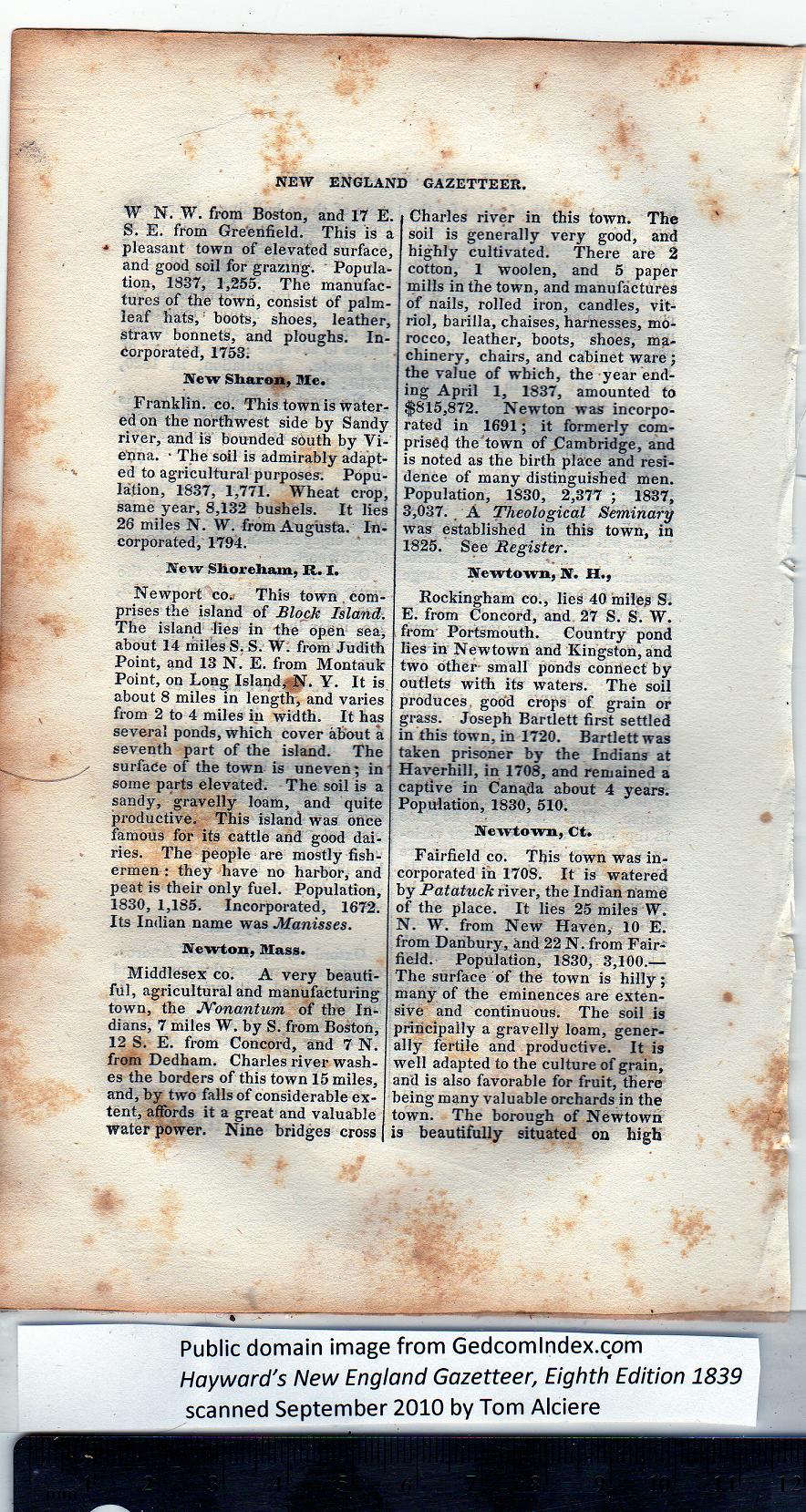|
W N. W. from Boston, and 17 E.
S. E. from Greenfield. This is a
pleasant town of elevated surface,
and good soil for grazing. Popula-
tion, 1837, 1,255. The manufac-
tures of the towii, consist of palm-
leaf hats, boots, shoes, leather,
straw bonnets, and ploughs. In-
corporated, 1753.
New Sharon, Me.
Franklin, co. This town is water-
ed on the northwest side by Sandy
river, and is bounded south by Vi-
enna. * The soil is admirably adapt-
ed to agricultural purposes. Popu-
lation, 1837, 1,771. Wheat crop,
same year, 8,132 bushels. It lies
26 miles N. W. from Augusta. In-
corporated, 1794.
New Slioreham, R. I.
Newport co. This town , com-
prises the island of Block Island.
The island lies in the open sea,
about 14 miles S. S. W. from Judith
Point, and 13 N. E. from Montauk
Point, on Long Island,-N. Y. It is
about 8 miles in length, and varies
from 2 to 4 miles in width. It has
several ponds, which cover about a
seventh part of the island. The
surface of the town is uneven; in
some parts elevated. The soil is a
sandy, gravelly loam, and quite
productive. This island was once
famous for its cattle and good dai-
ries. The people are mostly fish-
ermen : they have no harbor, and
peat is their only fuel. Population,
1830, 1,185. Incorporated, 1672.
Its Indian name was Manisses.
Newton, Mass.
Middlesex co. A very beauti-
ful, agricultural and manufacturing
town, the JYonantum of the In-
dians, 7 miles W. by S. from Boston,
12 S. E. from Concord, and 7 N.
from Dedham. Charles river wash-
es the borders of this town 15 miles,
and, by two falls of considerable ex-
tent, affords it a great and valuable
water power. Nine bridges cross | |
Charles river in this town. The
soil is generally very good, and
highly cultivated. There are 2
cotton, 1 woolen, and 5 paper
mills in the town, and manufactures
of nails, rolled iron, candles, vit-
riol, barilla, chaises, harnesses, mo-
rocco, leather, boots, shoes, ma-
chinery, chairs, and cabinet ware;
the value of which, the year end-
ing April 1, 1837, amounted to
$815,872. Newton was incorpo-
rated in 1691; it formerly com-
prised the town of Cambridge, and
is noted as the birth place and resi-
dence of many distinguished men.
Population, 1S30, 2,377 ; 1837,
3,037. A Theological Seminary
was established in this town, in
1825. See Register.
Newtown, N. H.,
Rockingham co., lies 40 miles S-
E. from Concord, and 27 S. S. W.
from Portsmouth. Country pond
lies in Newtown and Kingston, and
two other- small ponds connect by
outlets with its waters. The soil
produces good crops of grain or
grass. Joseph Bartlett first settled
in this town, in 1720. Bartlett was
taken prisoner by the Indians at
Haverhill, in 1708, and remained a
captive in Canada about 4 years.
Population, 1830, 510.
Newtown, Ct.
Fairfield co. This town was in-
corporated in 170S. It is watered
by Patatuck river, the Indian name
of the place. It lies 25 miles W.
N. W. from New Haven, 10 E.
from Danbury, and 22 N. from Fair-
field. Population, 1830, 3,100.—
The surface of the town is hilly;
many of the eminences are exten-
sive and continuous. The soil is
principally a gravelly loam, gener-
ally fertile and productive. It is
well adapted to the culture of grain,
and is also favorable for fruit, there
being many valuable orchards in the
town. The borough of Newtown
is beautifully situated on high |
